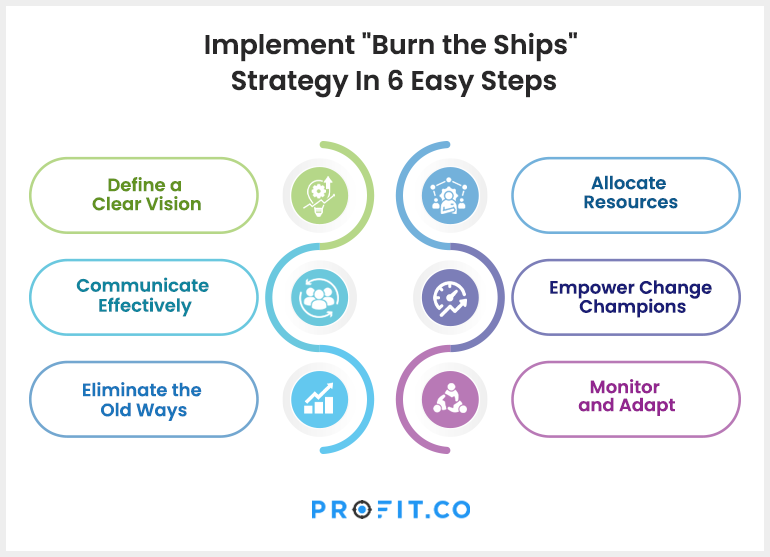Understanding the “Burn the Ships” Strategy
The phrase “burn the ships” originates from historical events where leaders, such as Hernán Cortés in 1519, ordered their ships to be burned upon reaching new lands. This drastic measure left their troops with no option but to move forward and conquer, as retreat was no longer possible. In a business setting, this strategy involves making a decisive commitment to change, eliminating the possibility of reverting to old ways.
Why “Burn the Ships” is Effective in Change Management?
Commitment and Focus: By eliminating the option to revert to old processes or systems, organizations ensure that everyone is focused on making the change successful. This high level of commitment often leads to greater effort and innovation.
Overcoming Resistance: Resistance to change is a common challenge. The “burn the ships” strategy forces employees to adapt, reducing the likelihood of clinging to outdated methods.
Creating a Sense of Urgency: This strategy instills a sense of urgency, motivating employees to quickly adapt and embrace new ways of working.
Clear Direction: It provides a clear direction for the organization, making it evident that the change is non-negotiable and essential for future success.
“Change is the law of life. And those who look only to the past or present are certain to miss the future.”
Real-World Examples of “Burn the Ships” in Business
Netflix: Transition from DVD Rental to Streaming
Netflix provides a quintessential example of the “burn the ships” strategy. In the early 2000s, Netflix was primarily a DVD rental service. Recognizing the potential of streaming, CEO Reed Hastings decided to pivot the company towards streaming content. This transition wasn’t easy, as it required significant investment in technology and licensing.
To ensure the success of this transition, Netflix gradually phased out its DVD rental business, making it clear to employees and customers alike that streaming was the future. This commitment paid off, as Netflix is now a global leader in streaming, with millions of subscribers worldwide. By burning the ships, Netflix ensured that all efforts were focused on building a robust streaming platform, leaving no room for retreat.
Adobe: Moving to a Subscription-Based Model
Adobe’s transition from selling perpetual software licenses to a subscription-based model with Adobe Creative Cloud is another example of the “burn the ships” strategy. Initially, Adobe faced backlash from customers who were accustomed to the old pricing model. However, the company firmly believed that the subscription model would provide more value through continuous updates and cloud services.
Adobe made a decisive shift, discontinuing the sale of perpetual licenses. This bold move forced customers to adapt to the new model. The result was a significant increase in recurring revenue, improved customer retention, and a more sustainable business model. Adobe’s commitment to the new strategy ensured its long-term success in a rapidly changing digital landscape.
To learn more about effective change management strategy
Blockbuster vs. Netflix: A Tale of Inaction
While Netflix’s success story highlights the benefits of burning the ships, Blockbuster’s failure serves as a cautionary tale of inaction. Despite recognizing the potential of digital streaming, Blockbuster chose to stick with its traditional brick-and-mortar rental model for too long. The reluctance to fully commit to a digital future allowed Netflix to capture the market, leading to Blockbuster’s eventual downfall.
This example underscores the importance of decisive action and commitment to change. Blockbuster’s inability to burn the ships and fully embrace the new model resulted in missed opportunities and an inability to compete effectively.
Microsoft: Embracing Cloud Computing
Under the leadership of Satya Nadella, Microsoft executed a successful “burn the ships” strategy by shifting its focus from traditional software to cloud computing. The introduction of Microsoft Azure marked a significant shift in the company’s strategy, moving away from its reliance on Windows and Office licenses.
Microsoft made substantial investments in cloud infrastructure and services, de-emphasizing traditional software sales. This bold move required retraining employees, redefining business models, and altering sales strategies. The commitment to cloud computing paid off, as Microsoft Azure is now one of the leading cloud platforms, contributing significantly to the company’s growth and profitability.

Implementing the “Burn the Ships” Strategy
To effectively implement the “burn the ships” strategy in a business change management initiative, consider the following steps:
- Define a Clear Vision: Clearly articulate the vision and objectives of the change. Ensure that all stakeholders understand the importance and benefits of the new direction.
- Communicate Effectively: Use transparent and consistent communication to convey the commitment to change. Address concerns and provide regular updates on progress.
- Eliminate the Old Ways: Gradually phase out old systems and processes. Set firm deadlines for the transition and ensure that no fallbacks are available.
- Allocate Resources: Invest in the necessary resources, including training, technology, and support, to facilitate the transition.
- Empower Change Champions: Identify and empower change champions within the organization who can advocate for the new way of working and support their peers.
- Monitor and Adapt: Continuously monitor the progress of the change initiative and be prepared to make adjustments as needed. Gather feedback and address issues promptly.
Demonstrate full commitment
The “burn the ships” strategy is a powerful approach to change management that emphasizes total commitment and decisive action. By eliminating the possibility of reverting to old ways, organizations can overcome resistance, create a sense of urgency, and ensure a clear focus on the new direction. Real-world examples from companies like Netflix, Adobe, and Microsoft illustrate the effectiveness of this strategy in driving successful transformations. In an ever-evolving business landscape, the willingness to burn the ships and fully embrace change can be the key to long-term success and competitive advantage.

